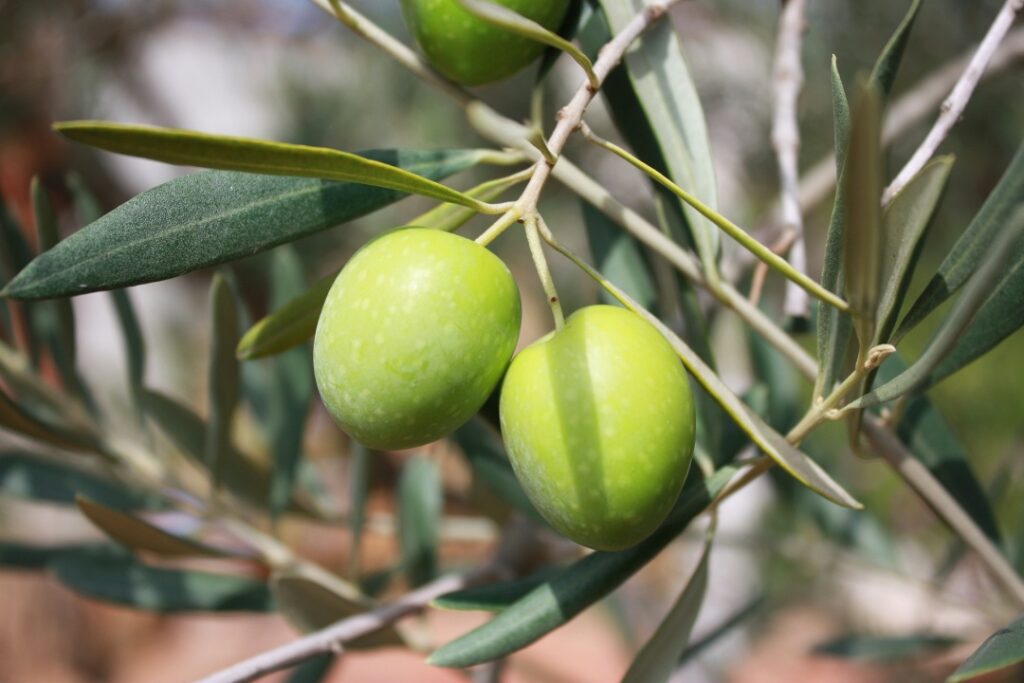
Palestine
(West Bank and the Gaza Strip)
Olive tree
Olea europaea

General Description / Cultural Significance
Olive Trees (Olea europaea) reach heights from 10 to 40 feet (3 to 12 meters) and have been widely distributed through Palestine since biblical times. Their plentiful branches spring from a thick and knotted trunk. The Olive Tree takes up over 45% of the West Bank’s agricultural land and is a strong plant able to live and grow through periods of drought and inferior states of soil. When cut down, it is often able to regenerate from the roots. The oldest olive tree in the world grows near Bethlehem, in Palestine. According to the Palestinian Ministry of Agriculture, the tree is estimated to be around 5,000 years old. Many of these trees easily live from 500 to 1,000 years. Because of the tree’s longevity, it is passed down through generations and becomes intrinsically linked to a family’s history, endowing them with intense personal meaning.
The native tree is cultivated in the country for its olive fruit, used both for medicine and food, but especially to make olive oil. Olive oil is produced in such large quantities it takes up most of the harvest, however, the nation also uses olives in their culinary practices and for soap, including the famous Nablus olive oil soap made since ancient times. Olive leaves can be used for lowering blood pressure, and to treat rheumatism. The leaves are used to make tea to boost the immune system, and to defend against cold and flu. Olives are antioxidant, antibacterial, and anti-inflammatory.
The tree’s imagery inspires literature and visual art across Palestine and has through the ages. Even the pits of the olives are used by Palestinians for prayer beads. The Olive Tree has been a constant comforting presence and has served as a reminder to the Palestinian people of their ancient connection to their land and culture. An Olive Tree in every yard is a common sight, so it is no wonder that every asset of the tree is engrained into the culture and identity of Palestinians.
Climate Change / Conservation Status
The Olive Tree in Palestine faces two difficult forces in its venture of conservation: climate change and conflict. In 2021 the Ministry of Agriculture released a statement informing that olive production in Gaza had dropped approximately 65%. This massive drop is a result of climate change. Humidity and high temperatures have created unstable conditions for the trees, reducing their fertility by up to 80% because of ‘olive knot disease.’
In 2020, Israel and Palestine were hit with a scorching heat wave that broke record temperatures. Precipitation is decreasing dramatically, meaning water scarcity will become an even larger problem than it already is in the region. Storms will be far more frequent and difficult for infrastructure to handle.
There is a long history of purposeful destruction of the Olive Trees through conflict. The ancient trees are destroyed, making the land more susceptible to climate change through erosion and additional degradation of the landscape. Since 1967 over 800,000 Palestinian Olive Trees have been uprooted and destroyed with this number continuously growing.
The IUCN does not list Olea europaea as endangered for this region, as data is insufficient to tell, but the cycle of conflict between Israel and Palestine does not show signs of stopping, posing a significant threat to the survival of these ancient, endemic trees.
Alternate Names
Common Olive
European Olive
Olive
Sources
Diek, H. (n.d.). The Significance of the Olive Tree in Palestine. Bethlehem Bible College. https://bethbc.edu/blog/2021/10/28/the-significance-of-the-olive-tree-in-palestine/
Hedroug , L. (n.d.). Israel’s Campaign Against Palestinian Olive Trees. The Yale Review of International Studies. http://yris.yira.org/global-issue/6018
Khalil, S. H. (n.d.). Olive tree, za’atar, cactus: Palestine’s symbolic plants and the meanings behind them. Middle East Eye. https://www.middleeasteye.net/discover/palestine-plants-symbolic-meanings#:~:text=Palestine%20holds%20some%20of%20the,generations%20to%20look%20after%20them.
Kuttab, D. (n.d.). How the olive tree came to symbolize Palestinian national identity Previous. Arab News. https://www.arabnews.com/node/1976171/middle-east
Permanent Observer Mission of Palestine at United Nations. This statement can be found on the World Sensorium Original Website.
(n.d.). Climate Change Hits Gaza’s Green Gold. International Committee of the Red Cross. https://www.icrc.org/en/document/climate-change-hits-gazas-green-gold#:~:text=According%20to%20the%20Ministry%20of,in%20the%20last%20ten%20years.
(n.d.). Israeli forces uproot dozens of olive trees east of Bethlehem. Palestine News Agency. https://english.wafa.ps/Pages/Details/136507

